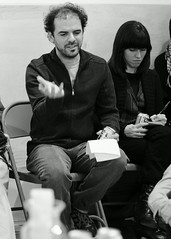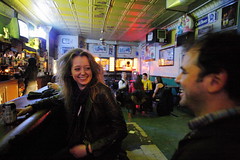The title of your Newcity article "Friends Curating Friends" contains the kernel of your most recent complaint.[1]
And you'd have your readers believe that the aforementioned piece is, in metaphor, nothing but a mirror held to Chicago's art world. That's fair enough, I suppose, because you're a critic. In any case, the reaction to a looking-glass bespeaks the nature of the person who stands before it.[2]
Having written that, rather than contest your action I'd like to turn your mirror just enough to allow you to reflect upon yourself and the profession that you practice.[3]
In fact, let's look together. For if it's the case that a curator has some ability to determine what is shown within an exhibition space, it's also true that critics have some ability to determine what appears in press. It follows: If "friends curating friends" is a phenomenon which merits attention, "friends covering friends" must too be an issue of import.
Well, how do you fare when your own work is subject to such scrutiny? Do we find that you've tended to praise certain parties regularly? blame certain parties regularly? About whom do we learn that you've been silent? Why?
Were I to stop here I think that you'd get the gist of it. Every complaint which you've made about the state of curatorial practice in Chicago applies equally well to the state of critical practice in Chicago. For example: "It’s not enough to have good intentions...one must do the legwork, conduct full-blown research and exploit untapped local resources. There is no excuse to not do so."[4]
Again, Pedro, what would we find if we employed your own heuristics and interviewed Chicago gallery owners in an effort to determine the amount of "legwork" which supports your criticism? You named the galleries Julius Caesar and Peregrine Program in your recent Newcity article: How often would their proprietors report having seen you under their shared roof?
It's no small point whether your local readership is upset with you for practicing art criticism--or criticizing art programs of which you have little practical experience.

"Little practical experience" describes well most of the authors of Chicago's arts coverage over the last five years. But, while you've railed against the "eternal puberty" which characterizes our alternative spaces, you've staunchly defended our critics--you know, your friends.[5]
It's now ironic that you were an invited speaker when many of us gathered together in one of Chicago's alternative spaces for the expressed purpose of discussing "crisis-free criticism" two years ago.[6]
What did we hear from you in that place? that there are no problems in art criticism in Chicago. Even earlier, in 2010, you used artnet.com to inform an international audience that Chicago was "well served" by the criticism published in a local, student newspaper.[7]
How is it possible to reconcile the standard which you've applied to critics with the standard which you've applied to curators?

I really like many of our young writers; I've no doubt that there are talents developing here. Whether they stay is another matter altogether. And to pretend that the loss of their predecessors is of no consequence is absurd. We have precious little memory of past events left alive in this city. In fact, twenty-five percent of the whole population of Chicago has been lost since 1970.[8]
Our criticism and attendant dialogue face this threefold challenge in development: (a) people need to travel miles in order to see spaces such as Julius Caesar and Peregrine Program; (b) people need to make such pilgrimages regularly; and, (c) people with such experience need to find a way to stay here, and participate in whatever conversations are ongoing.
Most of us fall into a rut. And if the reason that we see the same things again-and-again is that we're bound to do so by our ties of friendship, the consequence is that our opinions, our prejudices, are ever more firmly reinforced.
We have no shortage of people with ideas about art; but if few people look at art then where do those ideas about art originate? From where do your ideas come, Pedro?
Over the course of the last several weeks I've met, informally, with artists, publishers, and staff from various organizations in the city. My aim has been to better understand what it might be possible to do with my archive of Chicago art photography. I'd like to bring the project to some tangible conclusion, whether in the form of a book or exhibition. This series of meetings related to my own practice seems good to mention here because everyone involved has gotten the same spiel from me: a show of such images, derived from locations across the city, over time, might provide an occasion both for new names to be learned and also for familiar names to be understood in a new way. I think that's important. Performance and other time-sensitive, audience-involved, site-specific works typically are lost to history after the opening night; and studio visits don't provide a substitute for the missing experience. The documentary practice itself has made obvious that most visual art events are not well-attended.
That's "The Chicago Problem" in a word: audience. The competition for audience here is fierce. Our art schools produce more artists, and our artists produce more works of art, than we have interested curators, gallerists, collectors, and critics to engage. So efforts are made, ever more frequently, to combine artwork with food, and drink, and music, in order to appeal to a broader audience.
Or it's begun to dawn upon people that the easiest way to make money in the art world is not by showing and selling art, but rather by selling things to artists, e.g., residencies, webinars, and certificates. Because "striking it rich" is as rare in the field of culture as it was anywhere in the Gold Rush, it's safer to make money supplying other people as they risk the long odds.
We've probably got six commercial galleries relevant to a serious career (Kavi, Shane, Monique, and you can name the other three as you like) and six MFA programs disgorging new graduates every year.[9]
It's inevitable that non-traditional arrangements evolve to keep our annual raft of hopefuls afloat--if only long enough to drift away to one coast or another. If there isn't money, or fame, or even much good lighting to sustain the effort here, maybe friendship isn't the worst thing?

I thought that we had some bond of friendship, or at least some collegial understanding, when I spoke to you and Robin in a tavern on January 25, 2013.[10]
I'd just finished driving the two of you around town: we'd gone from opening to opening, and I'd made introductions, sharing names and history all along the way. However grim my own persona, whatever additional difficulties followed from Robin's article on MDW, I wanted, I really wanted, to try to bridge the gaps between groups--rather than burn any remaining bridges.[11]
You argued with me about Chicago. You told me that Chicago was no different than any other city in America.
In response I gave to you what I gave to Shannon Stratton, Mike Nourse, Dana DeGiulio, Annie Heckman, and others in the prior weeks: a sketch of "The Chicago Problem" in which spatial distribution of phenomena, role of institutional connectivity, bottom-heavy proportions, lack of record, and friendship figured prominently.[12]
You took that, Pedro, and you ran with it--for the purpose of throwing it at our curators and our alternative spaces on February 5, 2013, in your "Friends Curating Friends" article at Newcity. Why, for the love of God, why did you do it? And why do you persist in repeating on-line that any subsequent upset has stemmed from your honesty and good work as a critic? Where do you expect the discussion to go at this point?
Paul.
[1] http://art.newcity.com/2013/02/05/eye-exam-friends-curating-friends/
[2] See: Myth of Narcissus and Oscar Wilde's use of Shakespeare's character Caliban from "The Tempest," in Wilde's "The Picture of Dorian Gray" appended preface.
[3] Xenophon's Simonides.
[4] Ibid.
[5] http://www.artnet.com/magazineus/reviews/velez/2010-chicago-review1-13-11_detail.asp?picnum=19
[6] http://paulgermanos.blogspot.com/2011/03/editorial-winter-experiment-monique.html
Above: Group membership, love of the familiar, constellation of practices, etc., treated in addition to the "Crisis-Free Arts Criticism" discussion.
[7] http://www.artnet.com/magazineus/reviews/velez/2010-chicago-review1-13-11.asp
Above: "Academic art writing--criticism, theory and opinion--is well served in the city. Whitney Stoepel and Ania Szremski collaborate with F News Magazine..."
[8] http://www.census.gov/history/www/through_the_decades/fast_facts/1970_fast_facts.html
[9] http://blogs.artinfo.com/truestories/2012/11/11/self-ostracism-in-chicago-a-photo-essay/
Above: It's noteworthy that Michael Workman identified "student and post-graduate populations," as one of the city's strengths.
[10] http://www.flickr.com/photos/73059802@N00/8416843387/
[11] http://www.artfagcity.com/2012/11/14/smallness-and-sameness-at-chicagos-mdw-fair/
[12] http://neotericart.com/2011/12/05/art-criticism-in-chicago-dazed-and-confused-a-review-of-the-panel-discussion-at-the-school-of-the-art-institute-on-november-22-2011-by-diane-thodos/#comment-3122
Above: An outline of "The Chicago Problem" on-line in 2011.
No comments:
Post a Comment